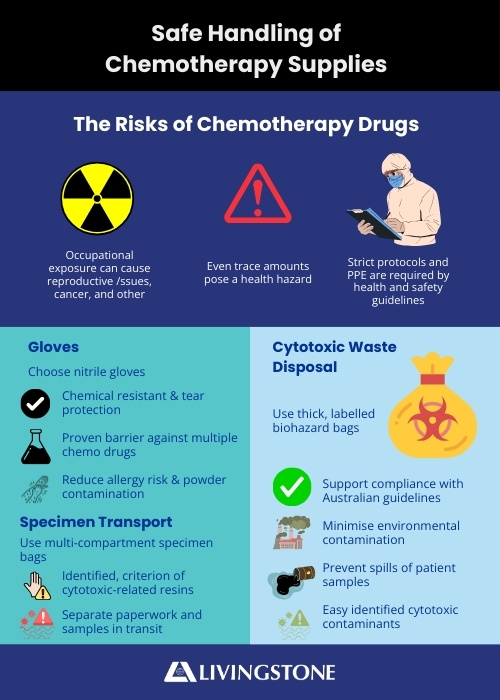Chemotherapy treatments save lives, but they also involve the handling of cytotoxic substances that pose serious health risks to both patients and healthcare workers. In clinical settings, exposure to these drugs can occur through skin contact, inhalation, or accidental ingestion, all of which require strict controls. As outlined in the SafeWork NSW Cytotoxic Drugs and Related Waste Risk Management Guide, improper handling may lead to long-term complications such as reproductive toxicity, organ damage, or even secondary cancers.
With growing awareness around these occupational hazards, it is essential to understand the key supplies required for safe chemotherapy handling and disposal, and how to select them responsibly. From gloves to biohazard containment systems, the right equipment protects not just the person administering treatment, but also support staff, patients’ families, and the surrounding environment.
The Risk Profile of Chemotherapy Drugs
Chemotherapy drugs are cytotoxic, meaning they are toxic to living cells. This makes them effective against cancer but dangerous to those who come into contact with them in even trace amounts. Studies have shown that occupational exposure to chemotherapy agents may lead to reproductive health effects, skin disorders, or even secondary malignancies in healthcare workers if proper precautions are not taken.
The National Institute for Occupational Safety and Health (NIOSH) categorises many chemo agents as hazardous drugs. As such, correct use of personal protective equipment (PPE) and compliant waste management practices is not just best practice, it is essential.
Choosing the Right Chemotherapy Gloves
Not all gloves are created equal. When handling chemotherapy drugs, gloves must offer verified resistance to drug permeation and meet minimum thickness requirements.
Nitrile gloves are preferred for their chemical resistance and strength. They should be tested against multiple chemotherapy agents, provide tear resistance, and be free from latex proteins that can trigger allergic reactions. Gloves should also be powder-free to reduce contamination risk and should fit securely to maintain dexterity and minimise puncture risk.
For high-risk environments, gloves that exceed ASTM D6978-05 standards for chemotherapy protection are strongly advised. Selecting an option like extra-thick nitrile gloves formulated specifically for cytotoxic drug resistance ensures frontline staff are safeguarded during the preparation, administration, and disposal phases.
Why Cytotoxic Waste Disposal Matters
Chemotherapy drug residues can remain active in bodily fluids, contaminated sharps, dressings, and IV tubing. Improper disposal can lead to accidental contact or environmental contamination.

Australian guidelines, including those from the Clinical Oncology Society of Australia (COSA), recommend that all cytotoxic waste be disposed of in heavy-duty, clearly labelled containers. These containers should be puncture-resistant, leak-proof, and colour-coded (typically purple) to distinguish them from standard biohazard waste.
Biohazard bags used for cytotoxic waste should be made from thick plastic, be sealable, and conform to local health department and EPA requirements for medical waste segregation. Products like chemotherapy-labelled biohazard waste bags support safe collection and compliance in hospitals, oncology units, and compounding pharmacies.
Best Practices for Specimen Transport
During chemotherapy treatment, biological specimens may also be collected for lab testing or monitoring. In such cases, correct specimen containment is vital to prevent cross-contamination.
Multi-compartment biohazard specimen bags provide physical separation between documentation and sample containers, while also reducing spill risk. They should be zip-sealable, moisture-resistant, and clearly marked as biohazards. Colour-coded designs help quickly identify cytotoxic-related samples in transit, reducing errors during specimen handling.
Building a Chemotherapy-Safe Environment
Beyond individual supplies, institutions must invest in policies and procedures that reinforce a chemotherapy-safe workplace. This includes proper training, PPE supply auditing, and periodic review of compliance with national safety standards. The quality of gloves, bags, and transport tools can directly impact the effectiveness of these protocols.
While protective supplies may be small components in a clinical setting, their significance is anything but minor. Reliable sourcing, certification visibility, and product traceability are essential considerations when stocking chemotherapy PPE and disposal solutions.
References
- National Institute for Occupational Safety and Health (NIOSH). (2023). NIOSH List of Antineoplastic and Other Hazardous Drugs in Healthcare Settings. Available at: https://www.cdc.gov/niosh/docs/2023-102/default.html (Accessed: 6 June 2025).
- Clinical Oncology Society of Australia. (2022). Guidelines for the Safe Handling of Cytotoxic Drugs in Healthcare Settings. Available at: https://www.cosa.org.au/media/332868/cytotoxic-handling-guidelines-2022.pdf (Accessed: 6 June 2025).
